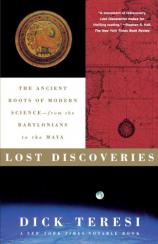Reading Group Guide
Discussion Questions
Lost Discoveries: The Ancient Roots of Modern Science--from the Babylonians to the Maya

1. During the golden age of Islamic civilization, from A.D. 750 onward, the Muslims flourished from North Africa to France, across Persia to China, and south to Northern India. Discuss this central location in Medieval Eurasia, in the midst of other cultures, which was a crucial developing site for most scientific practice in the world. What discoveries and inventions from India and China, ancient Greece and Hellenistic Egypt did they acquire? If, as Teresi maintains, "writing is the unification technology par excellence," characterize the role of Arab academic centers in transmitting the achievements of other cultures?
2. Today, we recognize Gutenberg as the father of modern printing, from his invention of 1454. The Chinese were using paper and movable type at least two centuries earlier, with the first completely printed book, the translation of a Sanskrit work into Chinese, surviving from A.D. 868. The math used in the Pythagorean Theorem, used by Egyptians was "lost" for generations. Are there political or sociological factors that prevented the spread of such achievements? What arrests progress in a civilization?
3. Encountering the divine was a very common feature of early "science." In most ancient cultures, astronomers were also priests. These realms of thought were never too distant for those observing the world and struggling to associate it with a cosmological understanding. Which natural events did the ancient Mesoamericans, the Inca, Maya, and Aztecs attribute to a divine presence. How did they use them to support their belief systems and their right to govern?
4. In early civilizations, natural phenomena were explained in terms of magic, experience, and religion. How did geological events and other physical forces figure in the Creation myths of ancient peoples? How do they shape their ideas of the structure of the universe? And how do these ideas resemble those put forward in modern physics today?
5. According to the Western thinker Francis Bacon, the three most important inventions to transform the antique and Medieval worlds into a modern age were gunpowder, paper and printing, and the magnetic compass. All three had origins (unrecognized) in China. What might be another essential unsung contribution to modern science? The numeration of the Indians? The geological records of Mesopotamia or the astronomical ones of China?
6. A traditional Western view of history holds that the Greeks founded original science, which was lost with the collapse of their civilization. Their works were preserved by the "custodial" Arab world during the middle ages until it was recovered by Enlightened Europe. In view of Teresi's vindication of ancient, Eastern, and non-Western sciences, the former model must be revised if not rejected altogether. What adjustments must be made to yield a more accurate picture of scientific enterprise as we now understand it: a story of rediscovery, or translation?
7. An early example of Egyptian math illustrates how to break nine loaves of bread among ten men. The alchemists who experimented with gold and metals, the shamans of Mesoamerica and Africa who developed early antibiotics -- were all inspired by necessity, a teleological mother of invention. Describe what other achievements, in agriculture, commerce, and religious practice stimulated purposeful innovation.
8. Ancient civilizations have left many clues about their passion for time. Rock sculptures in the American Midwest use light and shadow, much like the Egyptian pyramids and Aztec monuments, to tell the time of day and year. The Babylonians used a unique math with a base 60 system that was sensible to the spherical nature of the world and contributed to our modern sense of time. What was the nature of the relevance of time to ancient and early peoples? Is it linked to an obsession with the divine or, more centrally, a need to grasp the cosmological structure of the universe?
9. In early civilizations, natural phenomena were explained in terms of magic, experience, and religion. How did geological events and other physical forces figure in the Creation myths of ancient peoples? How do they shape their ideas of the structure of the universe? And how do these ideas resemble those put forward in modern physics today?
10. While some disciplines seemed more driven by theory, like math, and others by experiment, like early chemistry, the path of scientific discovery seems to have been a gradual integration of both approaches. Many ancient cultures had impressions of quantum theory and imaginative visions of chemical relationships, which resonate with the discoveries made possible by a modern interplay of theory and experiment in the last few hundred years. If sciences, and their tools -- like mathematical notation and the language of physics and chemistry, have become universal, can we hypothesize a natural progress of science? What long-range predictions about the future of science could we make?
11. If science began and first flourished in the nonwestern world, what happened? Why did science in the non-European world seem to stop dead in its tracks by the end of the middle ages? There are exceptions, such as Indian mathematics, which flourished until India was invaded by Britain. But mostly science has been a western endeavor since the Enlightenment. Teresi never addresses this problem. One common answer is that European scientists were able to throw off the handcuffs of religion. Yet religion inspired much of early science. What is your theory?
Lost Discoveries: The Ancient Roots of Modern Science--from the Babylonians to the Maya
- Publication Date: October 1, 2003
- Paperback: 464 pages
- Publisher: Simon & Schuster
- ISBN-10: 074324379X
- ISBN-13: 9780743243797







